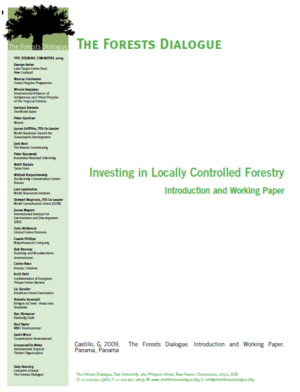Investing in Locally Controlled Forestry Introduction and Working Paper
Every time he walks into the forest, my grandfather says “a dialogue about forests is a dialogue with our brothers the trees. We must ask the trees and Mother Earth permission to take the day’s livelihood from them.” To speak about indigenous peoples and their lands is to speak about history, and to do so from a cultural perspective. But this conversation is not yet possible. Thus, this paper focuses on Panama and its indigenous peoples and lands—first and foremost, we must understand what it means to be indigenous. In Panama’s case, indigenous peoples are ruled by their own customs and traditions, as well as by specific laws. The comarca is legally recognized as indigenous peoples’ land, where all social, economic, and ecological activities; these are carried out in order to achieve sustainable development and according to the people’s specific world view. Panama has five comarcas: Ngöbe Bugle, Kuna Yala, Embara Wounaan, Madungandi and Wargandi, and Naso Teribe, which is currently under review by the Assembly of Representatives as well as within
Naso’s own congress. According to official estimates published by Panama’s Comptroller for the 2000-2015 period, the country’s population in 2008 reached 3,395,346, with a growth rate of approximately 1.66% between 2007 and 2008. The population within indigenous comarcas reached 323.234, which represents 9.5% of the Panama’s population. This paper discusses the Kunas’ experience in the management and development of the Nargana protected area (PEMASKY/AEK) and, specifically, the process leading to the creation of a strategic plan for this area, the “General Plan for the Management and Development of the Kuna Yala Comarca.” For this comarca’s management, the Plan proposes a “Biosphere Comarca” category; every activity carried out in PEMASKY follows the indigenous peoples’ right to “free, prior and informed consent (FPIC).” Additionally, this paper offers a view into the laws and norms that currently apply to forest management in Panama. Many of these laws stipulate the need for citizen and stakeholder participation, especially those whose livelihoods depend on the forests and are directly affected.
Finally, the paper recognizes potential conflicts among stakeholders who live in and from the forests or among landowners. There are two topics currently being debated of great importance to many interest groups in the civil society: the payment system necessary to reduce deforestation and the distribution of benefits among stakeholders.

